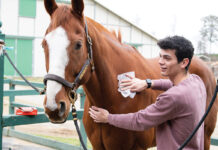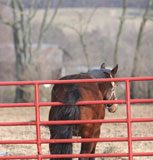- Grooming provides benefits beyond cleaning your horse, including increasing blood flow to muscles and skin, and building a bond with your horse.
- Grooming gloves, jelly scrubbers, and rub rags are useful additions to a grooming kit.
- Cleaning and maintenance of grooming tools makes them more effective.
The horse is a living, breathing piece of art. Keeping these exquisite creatures in peak condition involves many important tasks, but one key component is grooming. Two industry professionals share their thoughts with Horse Illustrated on how they take the familiar jobs of currying and brushing to the next level.

Why Grooming Matters
“Brushing and currying provide a massage to the skin, which helps increase blood flow to the skin and muscles,” says professional groom Cat Hill, co-author of World-Class Grooming for Horses. “It loosens dead hair and dirt that is deep in the coat. It’s also a great way to bond with your horse in a way that he understands on his level, since mutual grooming is a sign of trust and affection between horses.”
Assistant to world champion reiner Shawn Flarida, Alex Plowman believes grooming is an important part of management for top-level equine athletes.
“Keeping the horse clean and comfortable is a very crucial part of helping him give his best performance in the pen.
“The night before [a show class] we give the horse a bath, also washing and conditioning the mane and tail, so we’re starting out with a clean horse.
“When we go to get him ready to enter the pen, we use grooming spray on the body and all through the mane and tail. Next, we use a soft-bristled brush before putting the saddle on to make sure the hair is lying the right way under the tack. Finally, right before Shawn walks into the ring, we’ll look over the horse and take a rag to make sure the coat is nice and slick.”
In the Brush Box
There are all kinds of grooming tools available today featuring different colors, ergonomic designs, and more. But the basic categories still include curry combs, stiff brushes (dandy brushes), soft brushes (body brushes), grooming mitts, and rub rags and towels.
Hill stocks her grooming kit with each of the above, but also likes using a jelly scrubber because it has two sides: one with shorter, softer grooming teeth and the other with longer, firmer tips. This allows her to use the jelly on different types of horses, some of which enjoy a vigorous grooming and others with more sensitive skin. Hill also keeps a pair of grooming gloves at the ready.
“I love the gloves because I can use the fingertips to get into all the nooks and crannies,” says Hill. She especially likes the gloves for cleaning a horse’s legs, face and ears.
Plowman lists his top picks as an oval rubber curry comb, a variety of soft brushes, plus a towel and coat conditioner. They avoid using a comb on manes and tails at Shawn Flarida Reiners, preferring human hairbrushes or mane and tail brushes because the bristles are a bit softer and won’t break the hair.
Since most of the horses in the barn are in short coat year-round, he says they seldom use a stiff brush, and only use the curry comb when horses come in muddy or for young horses in full coat when they arrive for their first lessons prior to being started under saddle.
Another choice in selecting brushes is natural versus synthetic bristles. There are advantages and disadvantages to both.
“I really like natural bristle brushes because I groom a small number of horses and I love the way they make them shine,” says Hill. “But my business partner Emma Ford, who grooms event horses, prefers synthetic because she needs to disinfect them regularly. Bottom line, the best tools are the ones that your horse likes and that do the job properly.”
A softer touch is important when brushing the face, ears, legs, and other sensitive areas of the horse, such as the flanks. Muddy legs or faces may first require the careful use of a curry comb before following up with a brush.
Both professionals say that they use a soft brush and a towel on most horses when cleaning these touchy spots, but Hill says the soft side of a grooming mitt or grooming gloves are also useful in these instances.

Develop a Routine
One of the most important professional horse grooming tips is to develop a grooming routine with your horse. Is it necessary to groom your horse every day? Hill says your horse should be groomed as often as you can manage, but that horses should be absolutely be groomed every time they are exercised.
“The more work that is expected of a horse, the more time should be spent grooming,” she says. “Our upper-level horses get a pre-ride groom, a post-workout rubdown and a full groom in the afternoon every day.”
Both Hill and Plowman say that, in most cases, you should work from the front to the back of the horse when currying and brushing, although Hill says she varies the process for some horses.
“My general routine is to curry first,” she says. “It often depends on the horse. With sensitive horses, I start currying on their shoulder or rear, where they have large muscles, until they start to soften up and enjoy it. With more solid types, I start at the head/neck and work toward the tail.
“I curry every inch of a horse: their faces, legs, everything. Then I use a long-bristled ‘sweep’ brush in short, brisk strokes starting at the face, then work toward the rear, making sure to sweep down and up as I go back. Then I follow with a short-bristled body brush. Finally, I spray the horse with my favorite coat conditioner and use a wool mitt to sweep over them.”
The show horses and horses in training at Shawn Flarida Reiners are groomed before each ride and then are often rinsed or bathed afterward.
According to Hill, safety for human and horse should also be considered when brushing and currying. She advises observing your horse’s expression and body language as you begin to work. Your horse will indicate if a particular tool is bothering him or the amount of pressure is too much.
“Listen and change your methods if [he doesn’t] like what you’re doing,” says Hill. “Most importantly, try to keep a hand on your horse. He can’t really see you when you’re working on him, and taking your tool away and then putting it back on him can startle him.”
Top Grooming Tips
One of many professional horse grooming tips is to always pay attention to where you are grooming. Plowman says the main thing most people forget is grooming the horse’s belly where the girth goes.
“Always run the brush down there and make sure that the hair is going back toward their butt,” he says. “That way when you run the girth up, it’s not uncomfortable for the horse. It’s like putting a hat on with your hair upside down; your head is going to be tender. It is the same thing with horses.”
Another professional horse grooming tip is to always be moving when you are grooming. To be efficient in a grooming routine and give your horse maximum benefit of the therapy that grooming provides, Hill advises grooms to keep it moving.
“Sweat! You must move fast and you should be warm and moving when you curry. I put a brush in each hand—my sweep brush and my finish brush—so I only have to do each side once.”
Grooming is one of the most basic horsemanship lessons, but it’s worth doing well. Even if you’ve been grooming for years, follow these expert tips to polish your skills (and your horse) to a professional grade shine.
Care of Brushes
A big professional horse grooming tip is to take excellent care of all of your brushes. Grooming tools should be cleaned on a regular basis. Also check brushes and curry combs for broken bristles and missing teeth. Broken bristles can poke your horse’s skin and damage his coat, and too many missing bristles or teeth signal that it’s time to say goodbye to a brush or curry. Hill uses a variety of cleaning methods depending on the tools.
“I wash my hard tools with soap and water,” she says. “I sprinkle my natural- bristle brushes with cornstarch every few days (to absorb extra oil) and then spray them with a vinegar/water solution every few weeks. Synthetic brushes go in the dishwasher every month or so.”
At Shawn Flarida Reiners, the staff also washes their brushes on a regular basis. Plowman says that they use an agricultural wash that is biodegradable, non-toxic and non-corrosive.
“We also use it on our saddle pads, our girths and spray our bits down with it,” he says.
Meet the Experts
Cat Hill, 37, of Corning, N.Y., has 15 years of experience as a professional groom and has worked managing Arabian show horses, hunters, jumpers, eventers and dressage horses. She is co-author with Emma Ford of the book World Class Grooming for Horses.
Together Hill and Ford also operate World Class Grooming LLC, conducting clinics on grooming and horse management with the goal of elevating the relationship between horses and their caretakers.
Alex Plowman, 26, of Springfield, Ohio, works for Shawn Flarida, multiple World Equestrian Games reining gold medalist and the only $6 million reiner. A graduate of Murray State University in equestrian facilities management, Plowman’s duties at Shawn Flarida Reiners include grooming, riding and training, horse and barn management, and traveling with Flarida to shows.
This article originally appeared in the March 2019 issue of Horse Illustrated magazine. Click here to subscribe!






Hello I just want my horse to be the prettiest horse at my rodeos and I need a good long routine. I want my horses coat to be very slick and shiney. I also need a lot of help on my horses tail to. Please comment fast so I can get started fast